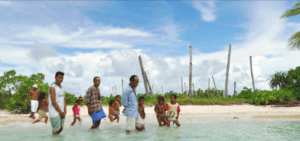
Villagers on the island of Abaiang had to relocate their village, Tebunginako, because of rising seas and erosion.
Credit: Justin Mcmanus/The AGE/Fairfax Media via Getty
Anote Tong can remember when Tebunginako, on the central Pacific island nation of Kiribati, was a thriving village.
But beginning in the 1970s, the tide started inching closer to the houses in the village. Over the years, as strong winds whipped up monster waves and climate change caused sea levels to rise, water inundated the island, overwhelming a seawall that had been built to protect the community.
Barely anything remains of the village today.
“It’s no longer there,” Tong said. “What we do have is a church sitting in the middle of the sea when the tide comes in.”
Tong served as president of Kiribati, a country made up of 32 atolls, from 2003 to 2016. Over that time, he watched as erosion damaged food crops, seawater flooded freshwater ponds and residents were forced to retreat.
He has become outspoken in describing the “existential threat from climate […]










